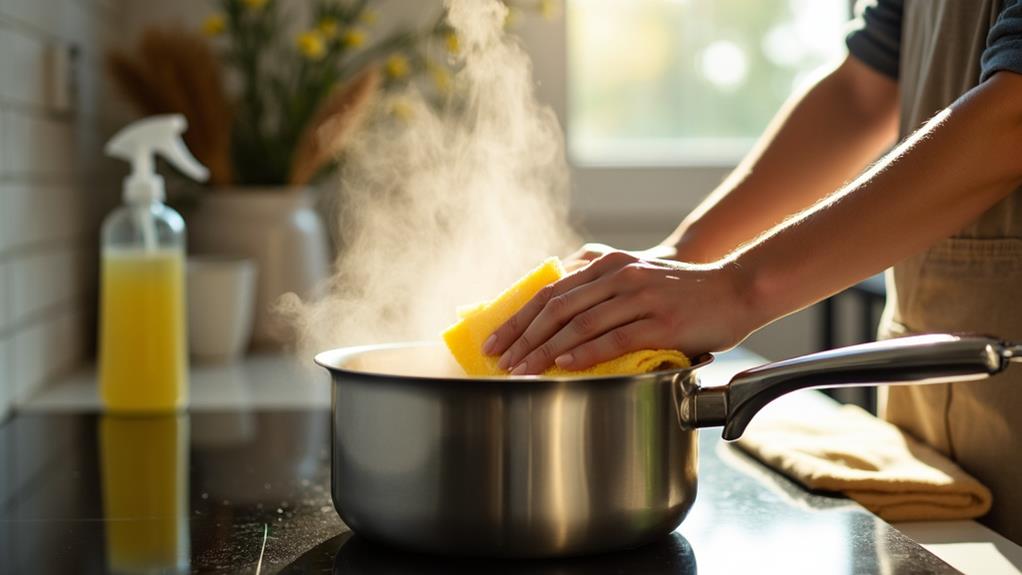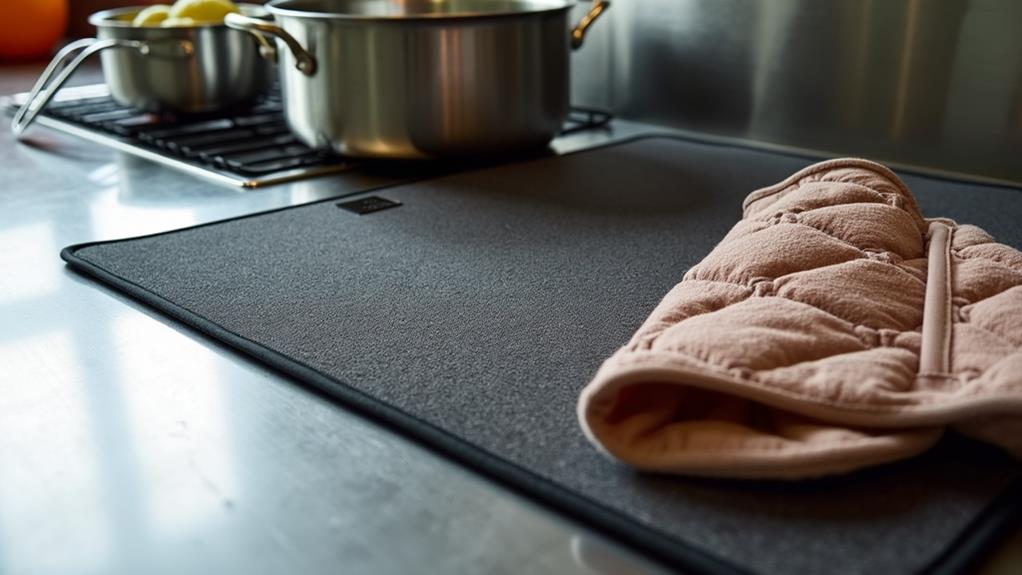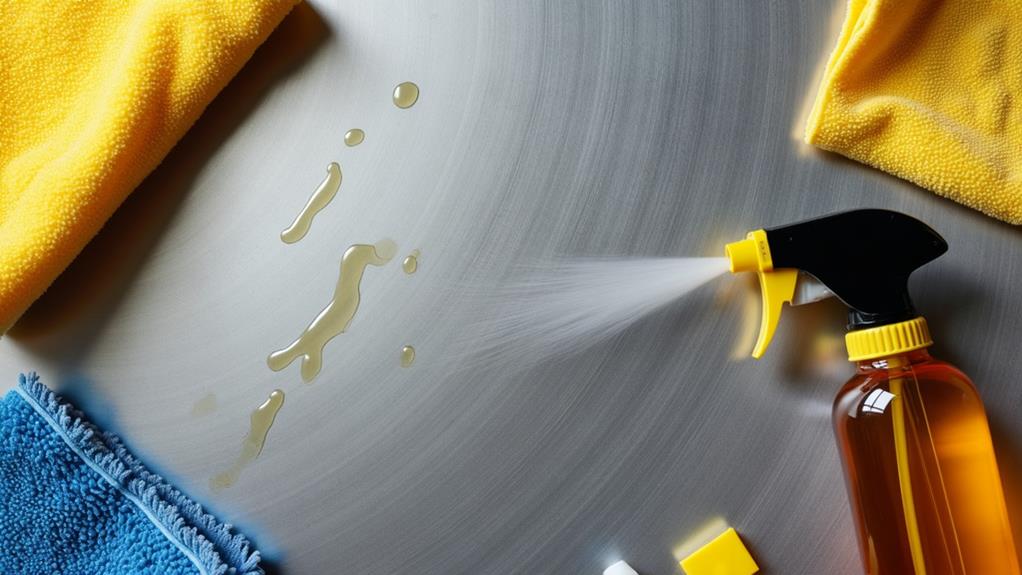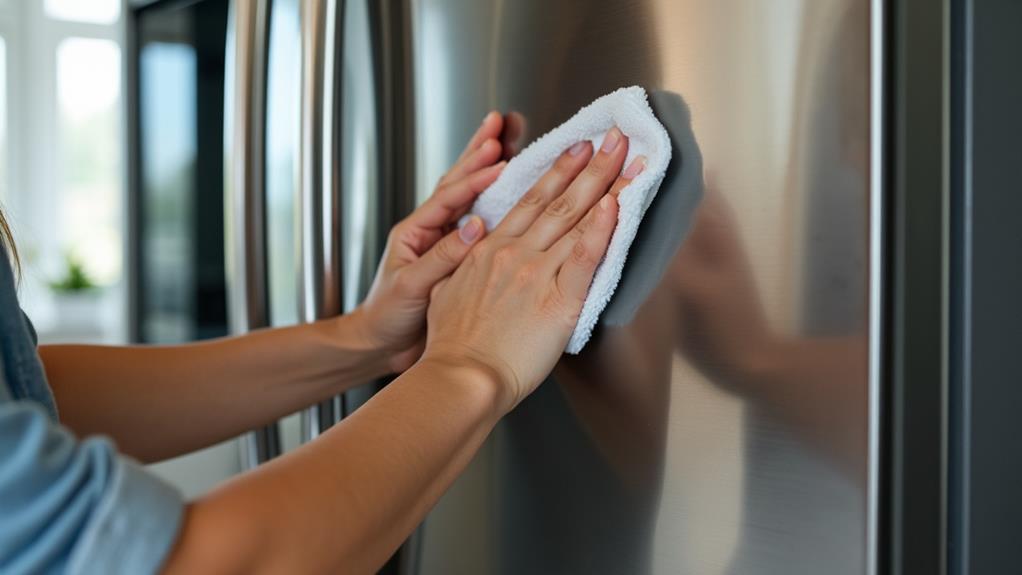How to Deep Clean Stainless Steel Cookware
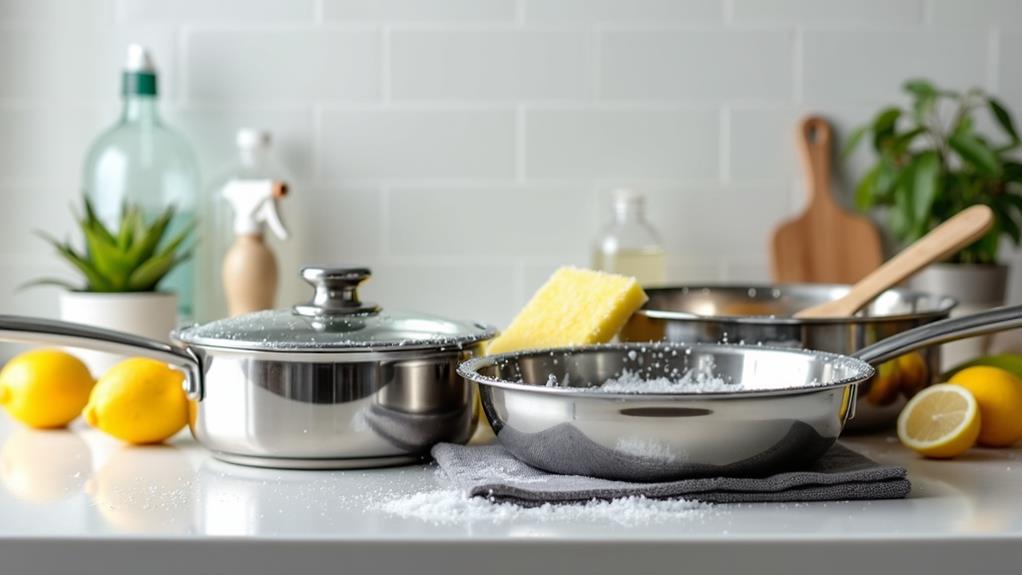
To deep clean stainless steel cookware, start by rinsing to remove loose food particles. Use mild dish soap and a soft sponge to scrub gently, then rinse and dry immediately to avoid water spots. For burnt-on food, boil water in the pan and use a wooden spoon to scrape off residue. Tackle discoloration with simmering vinegar, and stubborn stains with a baking soda paste. Eliminate water spots using a vinegar solution, scrubbing gently with a soft cloth. Polish with stainless steel cleaner or olive oil for shine. Follow these steps, and you'll soon uncover even more detailed tips.
Gather Your Supplies
Before you start deep cleaning your stainless steel cookware, you'll need to gather a few vital supplies. Initially, you'll want to have the right cleaning agents on hand. White vinegar and baking soda are excellent choices for tackling tough stains and burnt-on food. They're natural, effective, and safe for your stainless steel surfaces. You might also consider a commercial stainless steel cleaner if you prefer a ready-made solution.
Next, think about the scrub tools you'll need. A non-abrasive sponge or cloth is fundamental to avoid scratching your cookware. Microfiber cloths work well for buffing and polishing, giving your cookware a gleaming finish. For those hard-to-reach spots and stubborn residue, a soft-bristled brush can be particularly useful. Avoid steel wool or any harsh scrubbing pads as they can damage the stainless steel.
You'll also need a couple of extra items: a basin or large sink filled with warm, soapy water for initial soaking, and a towel for drying. With these supplies at your disposal, you're well-prepared to tackle the deep cleaning process and restore your cookware to its former glory.
Pre-Clean the Cookware
To kick off the deep cleaning process, start by pre-cleaning your stainless steel cookware. Initially, confirm you're practicing proper handling to avoid any scratches or damage. Begin by rinsing the cookware under warm water to remove loose food particles. Use a soft sponge or cloth for this step, as abrasive materials can harm your pots and pans.
Next, add a small amount of mild dish soap to your sponge and gently scrub the cookware. This basic cleaning step is vital for maintaining your cookware's shine and longevity, making it a part of your daily care routine. Rinse thoroughly to avoid any soap residue, which can become sticky over time.
Inspect your cookware for any remaining grease or food stains. If you find any, apply a bit more dish soap and give it another light scrub. Avoid using harsh chemicals or metal scrubbers to prevent any scratches or discoloration.
Dry the cookware immediately with a soft towel to prevent water spots. Proper handling at this stage sets the groundwork for a more thorough deep cleaning process. With your cookware pre-cleaned, you're now ready to tackle tougher stains and burnt-on food in the next step.
Tackle Burnt-On Food
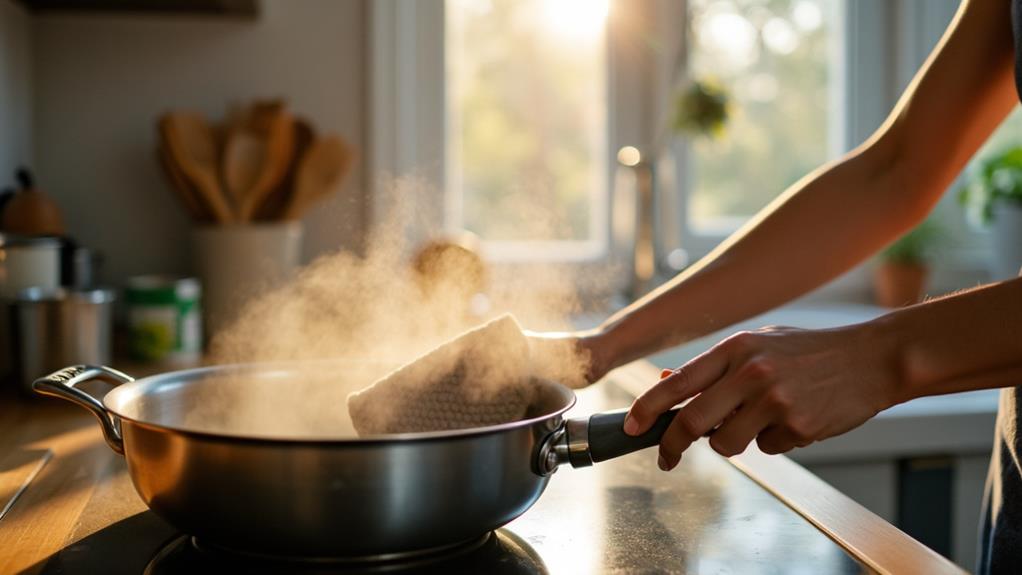
With your cookware now pre-cleaned, let's focus on tackling those stubborn burnt-on food stains. Start by filling the pan with enough water to cover the burnt residue completely. Bring the water to a boil, which helps to loosen the stubborn bits. After boiling for a few minutes, turn off the heat and let it cool slightly. Use a wooden spoon or spatula to gently scrape off the loosened food particles.
If the burnt residue persists, create a paste using baking soda and water. Apply the paste to the affected areas and let it sit for about 15 minutes. Baking soda's mildly abrasive nature works wonders in breaking down tough stains without scratching the stainless steel surface. After the paste has had time to work its magic, scrub the area using a non-abrasive scrub pad or sponge.
For extremely stubborn spots, you might need to repeat these steps or employ a dedicated stainless steel cleaner. Remember, patience is key. By maintaining proper cooking techniques, like using appropriate heat levels and stirring frequently, you can prevent future burnt-on food incidents. Now, you've got a clean base to continue restoring your cookware to its original shine.
Remove Discoloration
Discoloration on stainless steel cookware often results from overheating, which causes a rainbow-like effect or blueish tinge on the surface. These discoloration causes are common and can be fixed with a few simple steps. Initially, fill the discolored pot or pan with enough white vinegar to cover the affected area. Heat the vinegar until it simmers, then let it cool. The acetic acid in the vinegar will help to break down the discoloration. After the vinegar has cooled, scrub the area with a non-abrasive sponge, then rinse thoroughly.
To prevent future discoloration, use these prevention methods: avoid cooking on high heat unless necessary and verify the pan is dry before placing it on the burner. Also, try not to preheat the pan empty for too long, as this can cause overheating. Always use a small amount of oil or water to create a buffer.
Another effective way to remove discoloration is by using a paste made from baking soda and water. Apply the paste to the discolored area, gently scrub with a soft cloth, and rinse well. By following these steps, you'll keep your stainless steel cookware looking shiny and new.
Eliminate Water Spots
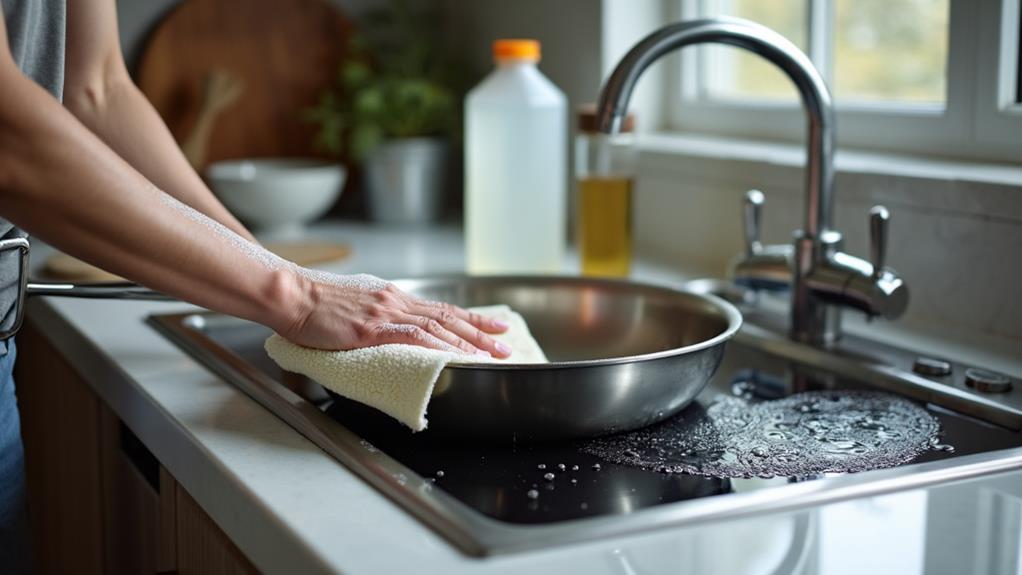
While tackling discoloration can restore your stainless steel cookware's sheen, dealing with those pesky water spots is another crucial step in keeping your pots and pans pristine. Water spots can dull the surface and make your cookware look less appealing. Luckily, water spot removal is straightforward and requires minimal effort.
First, create a vinegar solution by mixing equal parts of water and white vinegar. Pour this mixture into a spray bottle for easy application. Spray the vinegar solution generously over the affected areas of your cookware. Let it sit for about five to ten minutes. The acidic nature of vinegar helps break down the mineral deposits causing the water spots.
Next, take a soft cloth or sponge and gently scrub the surface, focusing on areas with visible spots. Avoid using abrasive materials that might scratch the stainless steel. Once the spots are gone, rinse the cookware thoroughly with warm water to remove any vinegar residue. Dry the cookware immediately with a soft towel to prevent new water spots from forming.
Address Stubborn Stains
Tackling stubborn stains on your stainless steel cookware can feel challenging, but it's entirely doable with the right approach. Start by making a paste with baking soda and water. Apply it to the stained area and scrub gently with a non-abrasive sponge. If the stain persists, try a vinegar solution—mix equal parts vinegar and water, bring it to a boil in the pan, then let it cool. The acid will help lift the stain.
Another effective method involves lemon juice and a salt scrub. Sprinkle salt over the stained area, then rub it with a half-cut lemon. The natural acidity and abrasiveness will work wonders. For more stubborn spots, create a paste with cream of tartar and water, apply it, and let it sit for a few minutes before scrubbing.
Olive oil can also help lift stubborn stains. Apply a small amount to a cloth and rub the affected area. For particularly tough stains, hydrogen peroxide combined with baking soda can be a game-changer. If all else fails, a commercial cleaner specifically designed for stainless steel cookware can provide a powerful solution. With these techniques, your cookware will be spotless in no time.
Polish for Shine
Once you've conquered those stubborn stains, it's time to bring back the gleam to your stainless steel cookware. To achieve a brilliant shine, you'll need to know the best polishing techniques. Start by using a soft cloth or microfiber towel. Apply a small amount of stainless steel polish or a natural polish alternative like olive oil or white vinegar. These natural options are not only effective but also eco-friendly.
Rub the polish onto the cookware in the direction of the grain. This helps avoid scratches and guarantees an even shine. Gentle, circular motions will also do the trick if you're unsure which way the grain runs. You don't need to use a lot of force; let the polish do the work.
If you're looking for a natural polish alternative, try making a paste with baking soda and water. Apply it with a soft cloth, then buff it out with a clean, dry cloth. This method is excellent for enhancing the shine without chemicals.
Rinse and Dry
After polishing, it is vital to rinse your stainless steel cookware thoroughly to remove any residual polish or cleaning agents. Begin by using warm water with a gentle flow. Hold the cookware under the tap, guaranteeing every inch is thoroughly rinsed. Pay close attention to crevices and joints where cleaning agents might settle. You can use a soft sponge to help guide the water and dislodge any remaining residue. This guarantees that no abrasive materials are left behind, which could harm the cookware.
Once you've completed the rinse, it's time to dry. Drying methods are significant to prevent water spots and maintain that polished shine. Use a clean, soft microfiber cloth to gently pat the cookware dry. Microfiber is effective because it absorbs water without leaving lint. Make sure you cover all areas, including handles and rims. If you prefer air drying, place the cookware upside down on a drying rack, allowing water to drain fully. However, manual drying is usually more effective in preventing streaks and spots.
Maintenance Tips
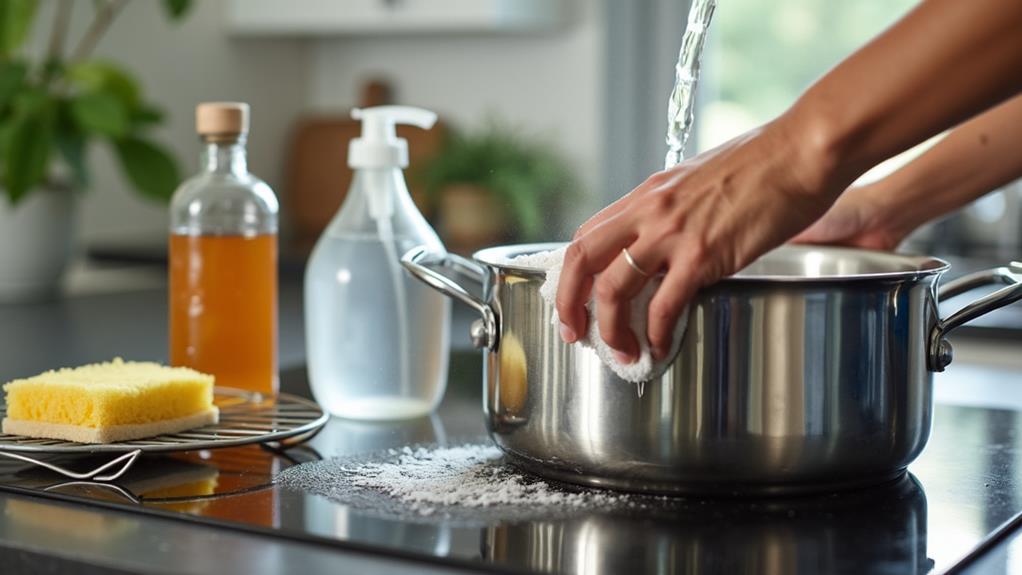
How can you keep your stainless steel cookware looking pristine for the long haul? It's all about consistent care techniques and the right cleaning frequency. By integrating these into your routine, you'll maintain that gleaming finish for years to come.
First, always hand wash your cookware. Dishwashers can be harsh, causing discoloration and reducing the lifespan of your pots and pans. Use warm water, mild dish soap, and a soft sponge to avoid scratches.
Second, avoid high heat. Stainless steel conducts heat efficiently, so medium to low settings are usually sufficient. High heat can cause discoloration and damage over time.
Third, tackle stains and discoloration immediately. For stubborn spots, make a paste with baking soda and water, then gently scrub with a non-abrasive pad.
Lastly, store your cookware properly. Stack carefully with a soft cloth or paper towel between each piece to prevent scratches.
Here's a quick recap for easy reference:
- Hand wash with mild soap and a soft sponge
- Use medium to low heat settings
- Address stains with a baking soda paste
- Stack with care using soft cloths or paper towels
Implement these care techniques and maintain an appropriate cleaning frequency to keep your stainless steel cookware in top shape.

